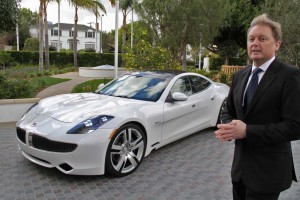With the fate of its $528 million Department of Energy loan in limbo, Fisker Automotive has been rushing to sign up new investors, reportedly already lining up $260 million during recent months. But the California start-up could be facing new problems in the form of a lawsuit by an investor accusing it of bait-and-switch tactics.
Though it’s unlikely the suit itself could bring a major new financial burden on Fisker, several observers cautioned it could create another management diversion and throw up a red flag that might scare off other potential investors.
The timing, meanwhile, couldn’t be worse. Fisker is finally getting to market with the much-delayed Karma plug-in hybrid sports car, but it needs additional funding to ensure that the company’s more mainstream second project, codenamed Project Nina, gets into production in 2013 – also about a year behind schedule.
(For a review of the Fisker Karma, Click Here.)
As TheDetroitBureau.com reported earlier this month, Fisker founder Henrik Fisker acknowledged his company has not drawn funds from the DoE loan since May of last year. But he also noted that the battery-car maker has been able to line up about $243 million out of a planned $300 million Series D financing round.
Unfortunately, the maker appears to have angered Daniel Wray, an earlier investor, by notifying stockholders they’d have to come up with additional money or possibly lose some of their shareholder rights. In Wray’s case, that would have meant another $84,000.
That prompted Wray to file a lawsuit demanding reimbursement of his original investment, along with damages. Accusing the company of engaging in “bait-and-switch” tactics, Wray’s attorneys argued that he “suffered significant money damages.”
News of the lawsuit comes shortly after Fisker revealed it had released 64 employees and contractors due to the delays in bringing the Project Nina vehicle to market. For his part, CEO Henrik Fisker insisted work on the vehicle is “95% complete,” and insisted that while the company “would like to continue working together with the Department of Energy…every good manager needs to have a Plan B.”
That would mean replacing the roughly $336 million in DoE loan money that Fisker had yet to tap into.
(For more on where things stand at Fisker Automotive, Click Here.)

